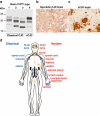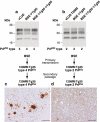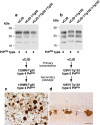Review: contribution of transgenic models to understanding human prion disease
- PMID: 20880036
- PMCID: PMC3017745
- DOI: 10.1111/j.1365-2990.2010.01129.x
Review: contribution of transgenic models to understanding human prion disease
Abstract
Transgenic mice expressing human prion protein in the absence of endogenous mouse prion protein faithfully replicate human prions. These models reproduce all of the key features of human disease, including long clinically silent incubation periods prior to fatal neurodegeneration with neuropathological phenotypes that mirror human prion strain diversity. Critical contributions to our understanding of human prion disease pathogenesis and aetiology have only been possible through the use of transgenic mice. These models have provided the basis for the conformational selection model of prion transmission barriers and have causally linked bovine spongiform encephalopathy with variant Creutzfeldt-Jakob disease. In the future these models will be essential for evaluating newly identified potentially zoonotic prion strains, for validating effective methods of prion decontamination and for developing effective therapeutic treatments for human prion disease.
© 2010 The Authors. Neuropathology and Applied Neurobiology © 2010 British Neuropathological Society.
Figures



References
-
- Collinge J. Prion diseases of humans and animals: their causes and molecular basis. Annu Rev Neurosci. 2001;24:519–50. - PubMed
-
- Weissmann C. The state of the prion. Nat Rev Microbiol. 2004;2:861–71. - PubMed
-
- Caughey B, Baron GS. Prions and their partners in crime. Nature. 2006;443:803–10. - PubMed
-
- Collinge J, Clarke A. A general model of prion strains and their pathogenicity. Science. 2007;318:930–6. - PubMed
Publication types
MeSH terms
Substances
Grants and funding
LinkOut - more resources
Full Text Sources

